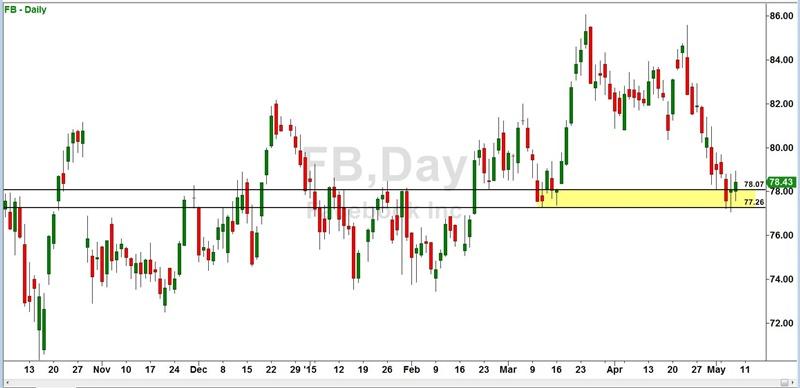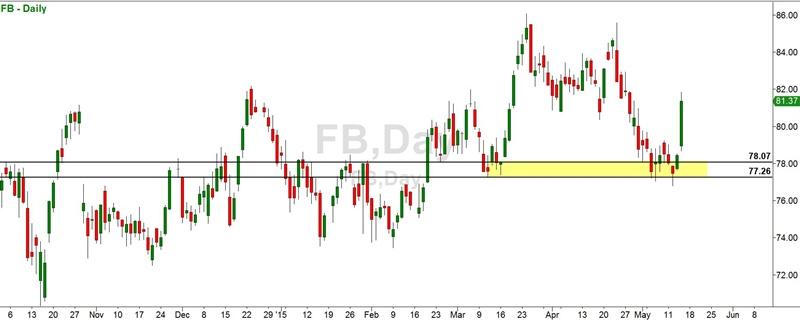Last week we looked at an opportunity in the stock of Facebook (FB). We compared buying the stock to buying call options on the stock. This is how the chart looked at that time:
A week later, on May 14, the chart appeared like this:
The stock popped on some favorable news and closed on May 14 at 81.37. That was a 3.7% increase. Meanwhile, the July 77.5 calls that we mentioned in the last article closed at $5.44, up from the $3.90 we quoted at that time. This was a 39.5% increase, or more than ten times the percentage increase in the stock itself.
Not bad so far. It looked to be a good start toward the move back to the recent highs around $86 that we thought likely. We’ll look in on this one again later.
For now, let’s look at a variation on this trade that could be even more profitable.
At the same time that the $77.50 calls were available for $3.90, there were call options at the $85.00 strike with a bid price of $1.07. These were too far above the current price of $78.43 to interest us as a buying opportunity, but instead of buying them we could have sold them at the same time that we bought the $77.50 calls. We would then be short those $85.00 calls. Selling a call option short obligates you to deliver the stock and accept the agreed-on price – in this case $85.00 – if the options are exercised by the other party. We did not expect the stock to get much higher than $85.00 by July, but if it did we would have to turn over the stock and accept $85.00 in payment.
Turn over what stock? We didn’t have any. Our only position was the $77.50 calls that we bought.
That’s fine. In any situation where we have to produce shares of stock (remember, somebody has to be willing to pay us $85.00 for that to happen), we could just exercise our own $77.50 calls and thereby buy the stock from someone else at that price. Our ownership of the $77.50 calls covers our obligation on the short $85.00 calls.
But what would be the point of selling the $85.00 calls? The point would be to collect the $1.07 per share that those calls would bring. That would reduce our net cost on the trade from $3.90 to $2.83 per share.
This type of position has a name. It is a vertical spread – one option at a strike price above another option. There are several varieties of it. In this one, the cost of the moneymaking $77.50 call is reduced by the amount received for selling the $85.00 call. If the stock does go up, the amount of profit is greater than with the long call alone in a wide price range.
Here, let’s say that the stock did go up to our $86.00 target at the July expiration. We could exercise our $77.50 calls and buy the stock at that price. Someone who had sold those $77.50 calls short would have to turn the stock over to us in exchange for our $77.50, even though the stock was much higher. That’s what they signed up for when they took our $3.90 originally.
We, in turn, would have to hand over the stock to someone who had bought the $85.00 calls from us and accept their $85.00 in payment (even though the stock was at $86.00). Net result: a gross profit of $7.50 per share ($85.00 in, $77.50 out).
From this $7.50 we have to subtract our net cost, which was $2.83 as described above. Net profit: $4.67 on a $2.83 investment, or 165%.
With the original $77.50 call only, without the short $85.00 call, our gross profit would be a little more at $8.50 ($86.00 less $77.50) but we would have to subtract the entire cost of the call at $3.90. That would leave a profit of $4.60 on a $3.90 investment, or 117%. That’s pretty darned good; but not as good as the 165% that we could make with the vertical spread.
This example highlights some of the unique features of options that make them so versatile. Tune in next time for more. Better yet, call your local center about our Professional Options Trader class.
This content is intended to provide educational information only. This information should not be construed as individual or customized legal, tax, financial or investment services. As each individual's situation is unique, a qualified professional should be consulted before making legal, tax, financial and investment decisions. The educational information provided in this article does not comprise any course or a part of any course that may be used as an educational credit for any certification purpose and will not prepare any User to be accredited for any licenses in any industry and will not prepare any User to get a job. Reproduced by permission from OTAcademy.com click here for Terms of Use: https://www.otacademy.com/about/terms
Editors’ Picks
EUR/USD extends sideways grind below 1.0900

EUR/USD stays in a consolidation phase below 1.0900 following the previous week's rally. In the absence of high-tier data releases, the US Dollar stays resilient against its rivals as investors scrutinize comments from central bank officials.
Gold retreated from record highs, maintains the upward bias

Gold rose sharply at the beginning of the week on escalating geopolitical tensions and touched a new all-time high of $2,450. With market mood improving modestly, XAU/USD erases a majority of its daily gains but manages to hold above $2,400.
GBP/USD holds steady near 1.2700, in an uneventful US session

GBP/USD fluctuates in a narrow channel near 1.2700 on the first trading day of the week. The cautious market stance helps the US Dollar hold its ground while central bank officials fail to trigger some action ahead of this week's key events.
Ripple stays above $0.50 on Monday as firm backs research on blockchain and quantum computing

XRP price holds steady above the $0.50 key support level and edges higher on Monday, trading at 0.5130 and rising 0.70% in the day at the time of writing.
Week ahead: Nvidia results and UK CPI falling back to target

What a week for investors. The Dow Jones reached a record high and closed last week above 40,000, for the first time ever. This is a major bullish signal even though gains for global stocks were fairly modest on Friday, and European stocks closed lower.
RECOMMENDED LESSONS
Making money in forex is easy if you know how the bankers trade!
Discover how to make money in forex is easy if you know how the bankers trade!
5 Forex News Events You Need To Know
In the fast moving world of currency markets, it is extremely important for new traders to know the list of important forex news...
Top 10 Chart Patterns Every Trader Should Know
Chart patterns are one of the most effective trading tools for a trader. They are pure price-action, and form on the basis of underlying buying and...
7 Ways to Avoid Forex Scams
The forex industry is recently seeing more and more scams. Here are 7 ways to avoid losing your money in such scams: Forex scams are becoming frequent. Michael Greenberg reports on luxurious expenses, including a submarine bought from the money taken from forex traders. Here’s another report of a forex fraud. So, how can we avoid falling in such forex scams?
What Are the 10 Fatal Mistakes Traders Make
Trading is exciting. Trading is hard. Trading is extremely hard. Some say that it takes more than 10,000 hours to master. Others believe that trading is the way to quick riches. They might be both wrong. What is important to know that no matter how experienced you are, mistakes will be part of the trading process.


